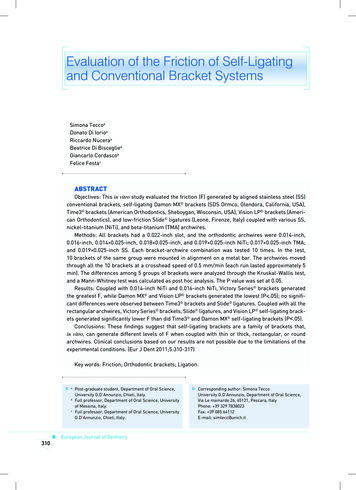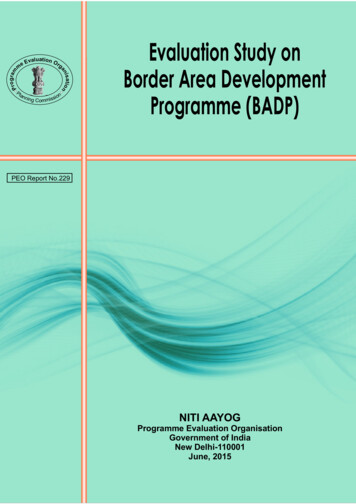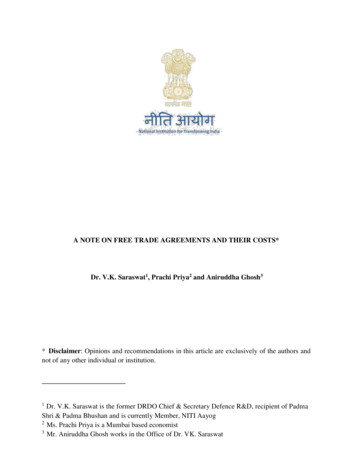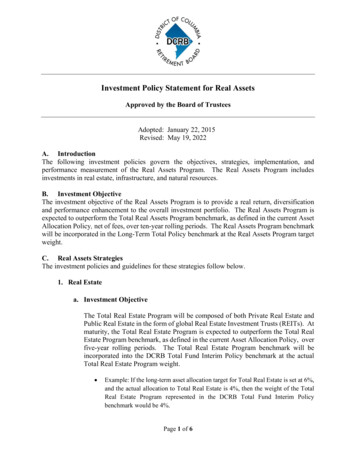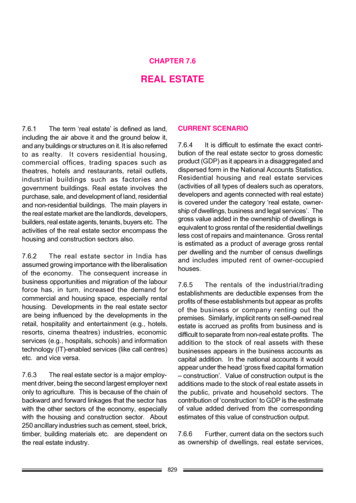
Transcription
CHAPTER 7.6REAL ESTATE7.6.1The term ‘real estate’ is defined as land,including the air above it and the ground below it,and any buildings or structures on it. It is also referredto as realty. It covers residential housing,commercial offices, trading spaces such astheatres, hotels and restaurants, retail outlets,industrial buildings such as factories andgovernment buildings. Real estate involves thepurchase, sale, and development of land, residentialand non-residential buildings. The main players inthe real estate market are the landlords, developers,builders, real estate agents, tenants, buyers etc. Theactivities of the real estate sector encompass thehousing and construction sectors also.7.6.2The real estate sector in India hasassumed growing importance with the liberalisationof the economy. The consequent increase inbusiness opportunities and migration of the labourforce has, in turn, increased the demand forcommercial and housing space, especially rentalhousing. Developments in the real estate sectorare being influenced by the developments in theretail, hospitality and entertainment (e.g., hotels,resorts, cinema theatres) industries, economicservices (e.g., hospitals, schools) and informationtechnology (IT)-enabled services (like call centres)etc. and vice versa.7.6.3The real estate sector is a major employment driver, being the second largest employer nextonly to agriculture. This is because of the chain ofbackward and forward linkages that the sector haswith the other sectors of the economy, especiallywith the housing and construction sector. About250 ancillary industries such as cement, steel, brick,timber, building materials etc. are dependent onthe real estate industry.CURRENT SCENARIO7.6.4It is difficult to estimate the exact contribution of the real estate sector to gross domesticproduct (GDP) as it appears in a disaggregated anddispersed form in the National Accounts Statistics.Residential housing and real estate services(activities of all types of dealers such as operators,developers and agents connected with real estate)is covered under the category ‘real estate, ownership of dwellings, business and legal services’. Thegross value added in the ownership of dwellings isequivalent to gross rental of the residential dwellingsless cost of repairs and maintenance. Gross rentalis estimated as a product of average gross rentalper dwelling and the number of census dwellingsand includes imputed rent of owner-occupiedhouses.7.6.5The rentals of the industrial/tradingestablishments are deductible expenses from theprofits of these establishments but appear as profitsof the business or company renting out thepremises. Similarly, implicit rents on self-owned realestate is accrued as profits from business and isdifficult to separate from non-real estate profits. Theaddition to the stock of real assets with thesebusinesses appears in the business accounts ascapital addition. In the national accounts it wouldappear under the head ‘gross fixed capital formation– construction’. Value of construction output is theadditions made to the stock of real estate assets inthe public, private and household sectors. Thecontribution of ‘construction’ to GDP is the estimateof value added derived from the correspondingestimates of this value of construction output.7.6.6Further, current data on the sectors suchas ownership of dwellings, real estate services,829
TENTH FIVE YEAR PLAN 2002-07Table 7.6.1Gross Domestic Product: Housing, Real Estate Services and Construction(at 1993-94 prices)Figures In Rs 94,0741,00,1701,04,7231,10,556HousingReal Estate ServicesTable 7.6.2Gross Domestic Product : Housing, Real Estate Services and Construction(at 1993-94 prices)(Share in Per Cent)YearHousingReal Estate 10.510.29.79.99.79.6Source : National Accounts Statistics 2001construction are mostly not available and estimatesfor the benchmark year is prepared on the basis ofbase year data and projected for other years withthe help of relevant indicators.1REFORM ISSUES7.6.7To get an idea of the contribution of thereal estate sector to GDP, an attempt is made tofactor in the value added to ownership of dwellings,which constitute housing, real estate services andconstruction.7.6.8During the period 1994-95 to 1999-2000the real estate services, housing and constructionsector grew by 4.6 per cent. The housing sectorgrew by 2.8 per cent only while the constructionsector grew by 6.4 per cent. Table 7.6.2 indicatesthat the share of real estate services, housing andconstruction in GDP declined steadily from 199394 to 1999-2000.7.6.9The Indian real estate market is still in itsinfancy, largely unorganised and dominated by alarge number of small players, with very few corporates or large players having national presence. TheIndian real estate market, as compared to the othermore developed Asian and Western markets ischaracterised by smaller size, lower availability ofgood quality space and higher prices. Supply ofurban land is largely controlled by state-owneddevelopment bodies like the Delhi DevelopmentAuthority (DDA) and Housing Boards leaving verylimited developed space free, which is controlledby a few major players in each city.7.6.10 Restrictive legislations and lack of transparency in transactions are other main impedimentsto the growth of this sector. Limited investment from830
REAL ESTATEorganised sector has also hindered the growth ofthis sector. There is a thriving parallel economy inreal estate, involving large amounts of undeclaredtransactions, mainly due to high stamp duty rates.The current legislative framework also leads tosubstantial losses to the Government. Some ofthese issues are:(a) Instruments of gift of immovable property;(b) other non-testamentary instruments whichpurport or operate to create, declare,assign, limit or extinguish, whether inpresent or in future, any right, title orinterest, whether vested or contingent, toor in immovable property;(c) non-testamentary instruments whichacknowledge the receipt or payment ofany consideration on account ofinstruments in (2) above.LEGISLATIVE ISSUES7.6.11 Much of the over 100 laws governingvarious aspects of real estate dates back to the 19thcentury. Despite the plethora of laws, the situationappears to be far from satisfactory and majoramendments to existing laws are required to makethem relevant to modern day requirements. TheCentral laws governing real estate include:(d) leases of immovable property from yearto year, or for any term exceeding oneyear, or reserving a yearly rentIndian Contract Act, 18727.6.12 This legislation specifies when a party canbe said to have the capacity to contract. A contractpertaining to realty can be entered into, amongothers, by an individual (who is not a minor or ofunsound mind), partners of a firm, a corporate body,a trust, a sole corporation, the manager of anundivided family, and a foreigner. All therequirements of a valid contract, i.e. consideration,intention to contract and validity under the law ofthe land must be satisfied.Transfer of Property Act, 18827.6.13 This lays down the general principles ofrealty, like part-performance and has provisions fordealing with property through sale, exchange,mortgage, lease, lien and gift. A person acquiringimmovable property or any share/interest in it ispresumed to have notice of the title of any other personwho was in actual possession of such property.Registration Act, 19087.6.14 The purpose of this Act is the conservationof evidence, assurances, title, publication ofdocuments and prevention of fraud. It details theformalities for registering an instrument. Instruments which it is mandatory to register include:7.6.15 Sales, mortgages (other than by way ofdeposit of title deeds) and exchanges of immovableproperty are required to be registered by virtue ofthe Transfer of Property Act. Evidently, therefore,all the above documents have to be in writing.Section 17 of the Act provides for optional registration. An unregistered document will not affectthe property comprised in it, nor be received asevidence of any transaction affecting such property(except as evidence of a contract in a suit for specificperformance or as evidence of part-performanceunder the Transfer of Property Act or as collateral),unless it has been registered. Thus the doctrine ofpart performance dealt with under Section 53 A ofthe Transfer of Property Act and the provision ofSection 49 of the Registration Act (which providethat an unregistered document cannot beadmissible as evidence in a court of law except assecondary evidence under the Indian Evidence Act)together protect the buyer in possession of anunregistered sale deed and cannot be dispossessed. The net effect has been that a large numberof property transactions have been accomplishedwithout proper registration. Further other instruments such as Agreement to Sell, General Powerof Attorney and Will have been indiscriminately usedto effect change of ownership.Special Relief Act, 19637.6.16 This Act is only to enforce individual civilrights. A person dispossessed of immovable831
TENTH FIVE YEAR PLAN 2002-07property without his consent (other than in duecourse of law) can recover possession by a suitfiled within six months from the date of dispossession. Unless the contrary is proved, in a suit forspecific performance of a contract, the Court shallpresume that a contract to transfer immovableproperty is one in which monetary compensationfor its non-performance would not afford adequaterelief. The Court could also grant a permanent/mandatory injunction preventing the breach of suchcontract and award damages.Urban Land (Ceiling And Regulation) Act(ULCRA), 19767.6.17 This legislation fixed a ceiling on thevacant urban land that a ‘person’ in urban agglomerations can acquire and hold. A person is definedto include an individual, a family, a firm, a company,or an association or body of individuals, whetherincorporated or not. This ceiling limit ranges from500-2,000 square metres (sq. m). Excess vacantland is either to be surrendered to the CompetentAuthority appointed under the Act for a smallcompensation, or to be developed by its holder onlyfor specified purposes. The Act provides forappropriate documents to show that the provisionsof this Act are not attracted or should be producedto the Registering officer before registeringinstruments compulsorily registrable under theRegistration Act.Government or any person duly authorised by theState Government in this regard under theprovisions of ULCRA. The repeal of the Act, it isbelieved, has eliminated the large amount oflitigation and released huge chunks of land into themarket. However the repeal of the Act has not beencarried out in all states. Initially the repeal Act wasapplicable in Haryana, Punjab and all the UnionTerritories. Subsequently, it has been adopted bythe State Governments of Uttar Pradesh, Gujarat,Karnataka, Madhya Pradesh and Rajasthan.Andhra Pradesh, Assam, Bihar, Maharashtra,Orissa and West Bengal have not adopted theRepeal Act so far.Land Acquisition Act, 18947.6.20 This Act authorises governments toacquire land for public purposes such as planneddevelopment, provisions for town or rural planning,provision for residential purpose to the poor orlandless and for carrying out any education, housingor health scheme of the Government. In its presentform, the Act hinders speedy acquisition of land atreasonable prices, resulting in cost overruns.The Indian Evidence Act, 18727.6.18 The objective of acquiring the excessvacant land could not be achieved because ofintrinsic deficiencies in the legislation itself. Theprovisions under Sections 19, 20 and 21 of the Acthave together proved counter-productive to theobjectives of the legislation. So far, only 19,020hectares could be taken possession of by StateGovernments and Union Territories and the remaining land was locked up in various litigations 2 . Thishas only helped push up land prices tounconscionable levels and practically brought thehousing industry to a stop.7.6.19 This legislation was repealed by theCentre in 1999. The Repeal Act, however, shall notaffect the vesting of the vacant land, which hasalready been taken possession by the State7.6.21 Under the Act, whenever the status of anyperson as the owner of a piece of immovableproperty of which he is shown to be in possessionis questioned, the burden of proving that he is notthe owner lies on the person who asserts that he isnot the owner.State laws governing real estate7.6.22 While each state has its own set of laws,which govern planned development, rules forconstruction and floor-area-ratio (FAR) or floorspace-index (FSI) and formation of societies andcondominiums, two laws that exist in every state,are the stamp duty and rent laws. Stamp Duty isbeing covered in a later section.Rent Control Act7.6.23 Rent legislation in India has been inexistence for a very long time. Rent control by the832
REAL ESTATEgovernment initially came as a temporary measureto protect the exploitation of tenants by landlordsafter the Second World War. However these rentcontrol acts became almost a permanent feature.Rent legislation provides payment of fair rent tolandlords and protection of tenants against eviction.Besides, it effectively allows the tenant to alienaterented property. Tenants occupying properties since1947 continue to pay rents fixed then, regardlessof inflation and the realty boom. Some of theadverse impacts of the Rent Control Act are: Negative effect on investment in housingfor rental purposes. Withdrawal of existing housing stock fromthe rental market. Accelerated deterioration of the physicalcondition of the housing stock. Stagnation of municipal property taxrevenue, as it is based on the rent. Resultant deterioration in the provision ofcivic services. Increase in litigation between landlords andtenants.7.6.24 The Rent Control Act, in fact, is the singlemost important reason for the proliferation of slumsin India by creating a serious shortage of affordablehousing for the low income families. Low andmiddle-income families typically live in rentedaccommodation all over the world and the need forsuch accommodation in our cities will only increaseas the economy modernises, labour mobilityincreases and urbanisation takes place. It is,therefore, necessary to increase the stock of rentalhousing. Promotion of rental housing can have asignificant impact on the economy in many ways: Housing has backward and forwardlinkages with many other industries. Rental housing helps in stabilising realestate prices and checking speculationand, thus, makes housing affordable forthe weaker sections. It helps check proliferation of slums.7.6.25 In the absence of rent control, dilapidatedurban housing would be periodically pulled downand replaced by modern apartment buildings andother complexes leading to more rational use ofprime locations and also creating a continuousprocess of urban renewal. This has not happenedin India because rent control combined with securityof tenure provides no incentive for house ownersto undertake renovation work. This explains the rundown appearance of many of our buildings in primelocations, which gives Indian cities a much moreshabby appearance than their counterparts in otherdeveloping countries. Repeal of the Rent ControlAct could unleash a construction boom as hashappened in many major cities all over the world.This is not only necessary to meet the growingunmet demand for housing but it would also have ahighly favourable effect on employment generation.7.6.26 In 1992, the Central Government proposed a model rent control legislation, which wascirculated to all states. The model Act proposedmodification of some of the existing provisionsregarding inheritance of tenancy and also defineda rent level beyond which rent control could notapply. A new Delhi Rent Control Act based on thismodel law was passed in 1997 but it has not beennotified to date because of resistance from traderswho are sitting tenants. Only a few states haveintroduced the model Act.TAXES AND STAMP DUTY RATESIt reduces shortage of housing for a largesection of the population who cannot affordownership.Stamp DutyHousing construction being a labourintensive activity, investment in housinggenerates employment for both skilled andunskilled labour.7.6.27 There is a direct link between RegistrationAct and Stamp Act. Stamp duty needs to be paidon all documents which are registered and the ratevaries from state to state. With stamp duty rates of833
TENTH FIVE YEAR PLAN 2002-0713 per cent in Delhi, 14.5 per cent in Uttar Pradeshand 12.5 per cent in Haryana, India has perhapsone of the highest levels of stamp duty. Some stateseven have double stamp incidence, first on landand then on its development. In contrast the maximum rate levied in most developed markets whetherin Singapore or Europe is in the range of 1-2 percent. Even the National Housing and Habitat Policy,1998, recommended a stamp duty rate of 2-3 percent. Most of the methods to avoid registration arebasically to avoid payment of high stamp duty.7.6.28 Another fallout of high stamp duty rates isthe understatement of the proceeds of a sale. Thisis also linked to payment of income tax and capitalgains tax. When registration has not been effected,a transfer is not deemed to have taken place andhence capital gains tax can be totally avoided. Thus,the present provisions in various laws and their poorimplementation have led to a situation where thereis considerable financial loss to the exchequer onaccount of understatement of sale proceeds, nonregistration and consequent non-payment of stampduty and avoidance of capital gains tax.Property Tax7.6.29 Property tax is a levy charged by themunicipal authorities for the upkeep of basic civicservices in the city. In India it is the owners ofproperty who are liable for the payment of municipaltaxes whereas in countries like the United Kingdom,the occupier is liable. Generally, the property tax islevied on the basis of reasonable rent at which theproperty might be let from year to year. The reasonable rent can be actual rent if it is found to be fairand reasonable. In the case of un-let proper-ties,the rental value is to be estimated on the basis ofletting rates in the locality. In the case of specialclass of properties like cinema theatres, it isestimated by adopting the accountancy methodunder which the rent is a certain percentage of thetotal average turnover during the year, i.e. actualreceipts of the sale of tickets (excludingentertainment duty).7.6.30 However, some cities follow a differentsystem for the levy of property tax. In Patna , localproperties have been categorised into three groups,834(i) reinforced cement concrete (RCC) buildings;(ii) pucca building; and (iii) pucca buildings with A.Cor C.I. sheet roof. The rental value per sqr.m. forevery building has been fixed according to theirstatus, location, type of construction and user etc.This system has been upheld by the Supreme Courtand has been appreciated by international bodies.In Delhi, property tax of un-let properties is basedon rental value, which is arrived at on the basis ofcapital investment in land and buildings. In the caseof rented properties, the rent recovered is taken asthe base.7.6.31 The rental value system has its own disadvantages. There is lot of discretion with theassessing officer. There is no buoyancy of revenuesbecause of the restrictions imposed by the RentControl Act. As a result, the rateable value of theproperties increases only on account of alterationsto or extension of the existing properties or onaccount of construction of new properties. As aresult of the Rent Control Act, the income of themunicipal corporations has become static. Themunicipal corporations are, therefore, in favour ofan alternative method of levying of property taxwhich will de-link it from rent.7.6.32 The Municipal Corporation of GreaterMumbai commissioned the Tata Institute of SocialSciences to undertake a study to recommend analternate system for levy of property tax. The studyhas recommended a capital value based system oftaxation. The advantages of this system are:(i)It results in revenue buoyancy, i.e. taxrevenue can keep pace with inflation andcost of living since capital value can berevised after five years based on themarket value of the residential propertiesgiven in the Government ready reckonerfor stamp duty.(ii)The system is transparent and simple.(iii) It is objective and eliminates/reduces theelement of discretion.(iv) It provides equitable assessment amongdifferent property owners.
REAL ESTATE7.6.33 The study has also developed a formulato work out the capital value and amount of tax:Capital Value Market value (MV) * Carpet area ofthe property * Weight for type of construction *Weight for age.Tax Capital Value * tax rate * weight for usercategory.7.6.34 While assigning weights, concessionshave been given to buildings like chawls, semipermanent structures, those constructed prior to1985 and those falling in the category of tenementshaving less than 225 square feet carpet area andbelonging to the economically weaker sections.Similarly, weights have also been assigned to theuser category in a progressive manner. The detailsof the weights assigned to each category may beseen at Annexure-7.6.1.Entertainment Tax7.6.35 The tax rates in the entertainment industryare among the highest in the world. Though someState Governments are waiving entertainment taxon multiplex theatres for periods ranging from threeto ten years, on the whole tax on film theatrescontinues to be high. Lowering of these rates willnot only benefit the entertainment industry, whichhas an annual turnover of Rs. 400 crore, but willalso promote real estate development in the formof theatres in cities, towns and even villages.LAND MARKET ISSUES7.6.36 It is estimated that removing land marketbarriers can contribute an additional 1 per cent toIndia’s GDP growth rate.3Titles and Records7.6.37 Another important issue in real estatedevelopment is that of title to property. In India, theState does not certify a title to housing or landproperty. The revenue records are not documentsof title, and ownership is established only by thesequence of earlier transfers. Thus, the fundamental question of title has often led to enormouslitigation. At present there are three legislationswhich have a bearing on property transactionsinvolving transfer of ownership of proprietary interest. These are the Transfer of Property Act, theIndian Registration Act and the Indian Evidence Act.7.6.38 An examination of the provisions of theseActs reveals a number of inadequacies. Most of thesale transactions are done through the power ofattorney route to evade transaction costs likeregistration, stamp duties, property tax etc. Thesystem, as it exists, imposes a responsibility on thepart of the purchaser with regard to the inspectionof the title. The result is tenuous titles to land andnon-transparency in property transactions, therebyhampering large-scale real estate development.7.6.39 Titles to land have become necessary formore efficient handling of land title documents, toprovide greater security of tenure for those inoccupation of land, to keep pace with the greaterdemand for re-conveyancing, for better support formortgaging and investment, to face the steadyincrease in the number of private and public userswho make routine enquiries about land ownership.7.6.40 There is an urgent need to ensure compulsory registration of land deeds and also to computerise such records so as to create a database. TheAndhra Pradesh experience is a good example tobegin with where registration of sale of land/propertyis achieved within a month. The Tenth Plan WorkingGroup on Information Technology for Masses hasrecommended computerisation of land records allover the country with computerised land/propertydocuments being available to the public at all levels,including in villages, by 2005. Through onlinedocumentation of land records, hyper links withcourt registries of the district or the State can bedeveloped, so that the unwary buyer can get immediate information of any pending litigations.7.6.41 In this context, the Registration and OtherRelated Laws (Amendment) Act, 2001 hasproposed the compulsory registration of documentsrelating to part performance of contracts concerningimmovable property (covered by Section 53A of theTransfer of Property Act), in order to prevent lossof revenue to the states. The Act also s eeks to curb835
TENTH FIVE YEAR PLAN 2002-07the practice of avoiding registration of deeds bytransferring property through power of attorney andagreements of sale. Though this Act has receivedthe assent of the President and has been notifiedin the official gazette, it will come into force onlyfrom a date to be notified by the Government.Urban Land Monopoly7.6.42 Many cities have created developmentagencies (like the DDA in Delhi) and handed overcontrol of all urban land within the municipaljurisdiction to them in the belief that they would actin the interests of the public. However, suchagencies tend to behave like the monopolies thatthey are. It is in the interests of the monopolist torestrict the development and sale of new land andkeep prices high, so as to maximise its own returns.Introduction of a competitive construction boomrequires abolishing the monopoly of such agenciesover urban land by completely separating controlof land from its development.7.6.43 There is a huge opportunity for leveragingthe large portfolios of unutilised and underutilisedreal estate assets of various government agencies.A conscious effort on the part of these agencies,coupled with policy initiatives, can unlock the valueof these non-performing assets. Revenues generated from such initiatives can be utilised for thedevelopment of infrastructure.7.6.44 Government staff housing : During Britishrule, official bungalows were built in exclusive civillines for government officials. This practice wasperpetuated after Independence and a large volumeof government housing for functionaries rangingfrom ministers and legislators to Class III and ClassIV employees, involving huge public expenditurewas developed during the past 50 years. In otherdemocracies such as the United States and UnitedKingdom, there is usually an official residence forthe elected chief executive and all other officialslive in owned or rented houses. Many economistshave proposed that all government housing including those in the Lutyens bungalows zone in Delhishould be handed over to the private sector andthe resources generated be invested for productivepurposes.8367.6.45 Public-Private Partnerships : Private participation in housing is giving way to the new mantraof public-private partnerships. Under this, thegovernment acquires the land which is thendeveloped for residential/commercial use by theprivate developer. One example is the ‘BengalAmbuja project’ in Kolkata, which is a joint venturebetween the West Bengal Housing Board and theGujarat Ambuja Cement Group. The housing projectcaters to the housing needs of various incomegroups by building ‘low density high rise’ buildings.7.6.46 Another example worth emulating is theHUDA model of the Haryana Urban DevelopmentAuthority (HUDA) under which a number ofintegrated cities have been developed throughpublic-private partnership (Annexure-7.6.2).Gurgaon has emerged as the most successful ofthese, with the country’s largest private sectorintegrated township DLF City being establishedthere. Development of integrated townships wouldmean development of residential, commercial,corporate and institutional complexes, besidesprovision of roads, power, water supply, wastemanagement, storm water drainage as also socialinfrastructure – medical, community and educationfacilities. A certain percentage of houses – around10 per cent — in these townships can be reservedfor the economically weaker sections (EWS) andlow-income groups (LIG) at affordable rates.Land Reforms7.6.47 The present ceiling of 15 - 25 acres perperson on agricultural holdings comes in the wayof large-scale real estate development, especiallywith the recent foreign direct investment (FDI) normsmaking it mandatory for having at least 100 acresof land for investment in integrated townships.Therefore one has to under the existing law findmethods of circumventing this by first convertingagricultural land within the limit into urban land andthen again purchasing more land in order to meetthe 100-acre limit for FDI. This would only lead todelays in projects. With the urban land ceilingremoved in most parts of the country, the agriculturalland holding ceiling with respect to land in theperiphery of towns needs to be looked into.
REAL ESTATEconform to fair trade practices and legal requirements. A scientifically graded project would lenditself to a more accurate and reliable estimation ofthe risks associated with the real estate project/project promoter. This is expected to enhance theconfidence of the end users and augment theinterest of the lenders in these projects, therebyfacilitating the flow of institutional funds to theproject/project owner. With the construction sectorreceiving industry status, it is expected that developers and companies will be able to borrow fromfinancial institutions on priority basis.Conversion of Rural Land to Urban Use7.6.48 Conversion of rural land at market pricesshould be completely de-controlled and left to themarket. At present, in Delhi, historical village landsituated within the city limits cannot be convertedto develop urban
the real estate market are the landlords, developers, builders, real estate agents, tenants, buyers etc. The activities of the real estate sector encompass the housing and construction sectors also. 7.6.2 The real estate sector in India has assumed growing importance with the liberalisation of the economy. The consequent increase in
